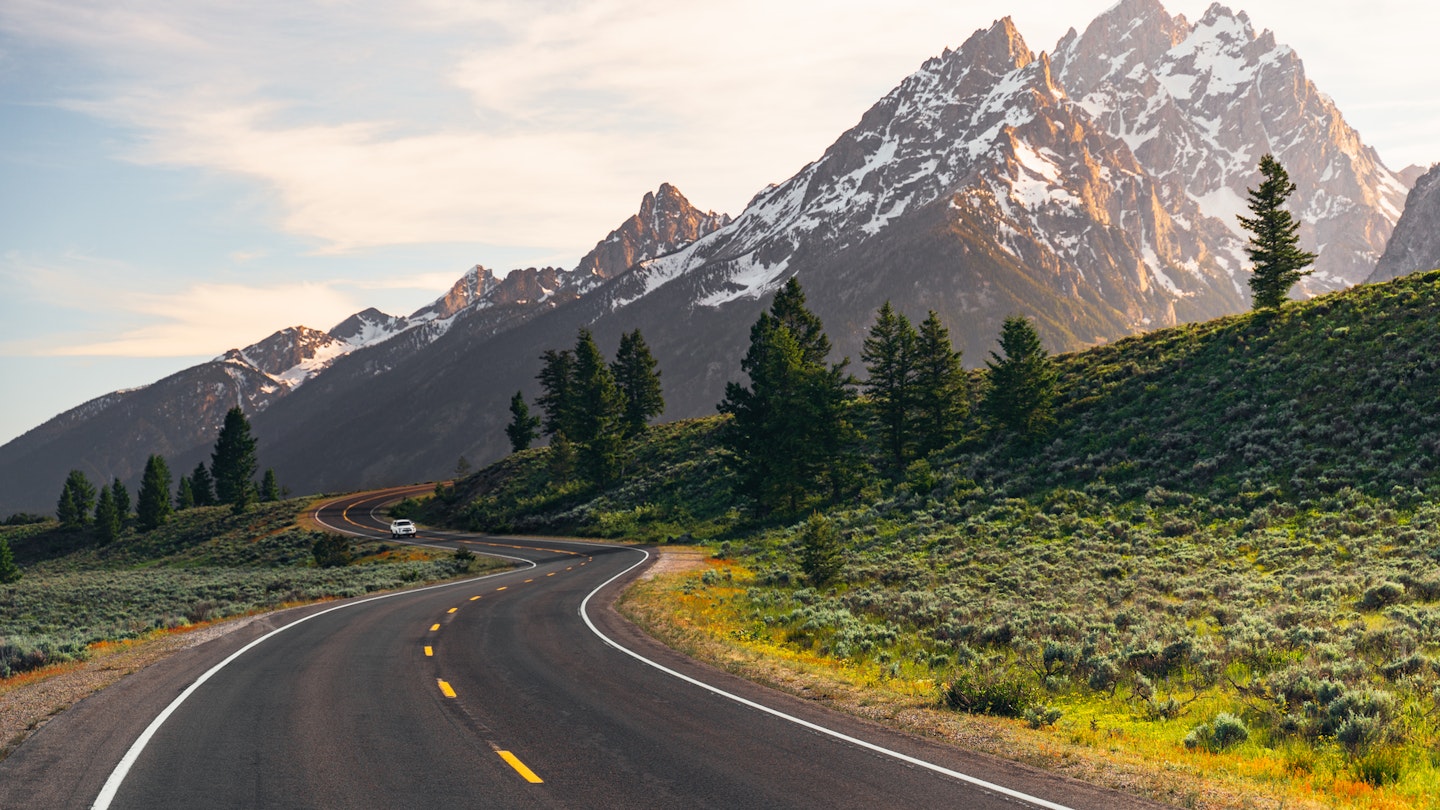At nearly 98,000 square miles, Wyoming has plenty of ground to cover. Although there are a few major interstates that make crisscrossing the state a breeze, some of the best sights and experiences are off the main drags.
Grab a map (you can’t depend on having cell service everywhere you travel), check road conditions, and get ready to explore. Just be prepared – many of these trips take you to isolated areas. Make sure to always carry a well-stocked emergency kit, good spare tire, and a full tank of gas.
Here are some road trip ideas to get you out and exploring Wyoming.
Wyoming’s Wild West
Best Road Trip to Spot Wildlife
Yellowstone National Park – Rock Springs; 400-550 miles; allow 6 days
Next to its geysers and thermal features, Wyoming’s wildlife deserves top billing in the state’s marquee outdoor attractions. Few areas on Earth are as biodiverse as the northwest corner of this fascinating state. Comprising 2.5 million acres of pristine wilderness, Yellowstone and Grand Teton National Parks make up the heart of the world’s largest intact temperate ecosystem. Moreover, the wider Yellowstone Ecosystem encompasses a dizzying 18 million acres, home to diverse fauna big and small. This tour takes you on a “greatest hits” of the state’s wild spaces.
Start off in Yellowstone National Park, home to the region’s “big five:” grizzly bears, black bears, bison, elk, moose, and gray wolves. In particular, the park’s wolf population, which has rebounded to about 120 animals due to preservation efforts, is noteworthy. The Hayden, Lamar, and Pelican Valleys are prime spots for wildlife viewing.
In neighboring Grand Teton National Park, Oxbow Bend is a favorite spot for spotting moose, pelicans, river otters, and other animals.

On the way south to Jackson, consider stopping at the National Elk Refuge to view elk (often seen in winter) as well as wolves, bison, and bighorn sheep. Guided sleigh ride tours are a family favorite – hop on a horse-drawn sleigh during the winter months to get an up-close look at elk and other wildlife on the refuge. As temperatures can drop, be sure to bundle up.
In Dubois, explore the National Bighorn Sheep Center, where you can learn all about bighorn sheep (the males’ horns can weigh up to 30 lbs!) and discover the center’s exhibits, which include life-size taxidermy mounts. Afterward, embark on the Pilot Butte Wild Horse Scenic Tour, a self-guided 24-mile route along a gravel road with opportunities to spot wild horses and other Wyoming wildlife. High-clearance four-wheel-drive vehicles are recommended on this scenic tour. Therefore, allocate 1.5-2 hours to drive the route while being mindful of variable road conditions.
For optimal exploration, it is suggested to spend three days in Yellowstone, two days in Grand Teton, half a day in Dubois, and a few hours on the Pilot Butte Wild Horse Scenic Tour.
Traveling Back in Time
Best Historic Road Trip
Fort Laramie – Fort Bridger State Historic Site; 434 miles; allow 2-3 days
In the 1800s, Wyoming served as a critical junction for several routes across the Western US. The California and Oregon Trails were the primary thoroughfares for those seeking wealth in the mountains and valleys of the West Coast. This historical route tracks their journey, starting at Fort Laramie National Historic Site, which evolved from a trading post in 1834 into a major military fort. The site today features restored buildings and an onsite museum, along with the nearby Bedlam Ruts, remnants of wagon paths.
Next, visit the National Historic Trails Interpretive Center in Casper, where interactive exhibits, including virtual stagecoach rides, await you. Moreover, be sure to stop at Bessemer Bend National Historic Site, an important crossing point for travelers in the 19th century.
As you continue westward, Independence Rock serves as a landmark where travelers etched their names into the 1900-foot-long rock. Lastly, the Fort Bridger State Historic Site marks a significant fork in the road for those progressing towards Salt Lake City or on the Oregon Trail. This site includes over a dozen historic structures on its 37-acre property.

Hot Springs Road Trip
Best Road Trip for Relaxing
Jackson – Saratoga Hot Springs Resort; 448 miles; allow 3-4 days
Known for having the highest concentration of thermal features in the world, Yellowstone National Park is surrounded by numerous hot springs. Start your relaxing tour at Astoria Hot Springs, located about 20 minutes south of Jackson. The park offers five pools along the Snake River with stunning views. It is advisable to make reservations in advance.
Your next stop is Thermopolis, home to Hot Springs State Park, featuring 104-degree water in its bathhouse and a “mineral terrace.” Notably, Star Plunge offers additional fun in Thermopolis with its pools and water slides.
Finally, the Saratoga Hot Springs Resort features a long hot springs pool and smaller, hotter pools, which are only accessible to guests or those receiving spa treatments, so reservations are highly recommended.
The Dino Track
Best Road Trip for Fossil Lovers
Kemmerer – Greybull; 333 miles; allow 2-3 days
Begin this trip at Fossil Butte National Monument, known as “America’s Aquarium in Stone,” where ranger programs and fossil demonstrations offer insights into prehistoric life. Explore the visitor center exhibits, which include over 400 fossil specimens. Your next stop is American Fossil, where you can try your hand at fossil digging and keep whatever you find.
As you continue northeast, be sure to visit the Wyoming Dinosaur Center in Thermopolis, showcasing skeletons and fossils, with additional paleontological experiences. Conclude your trip at the Red Gulch Dinosaur Tracksite, Wyoming’s largest preserved dinosaur footprint area, featuring trails, picnic tables, and interpretive signs. Be prepared for rugged conditions and keep an eye out for wary wildlife.




